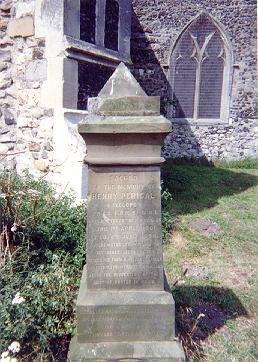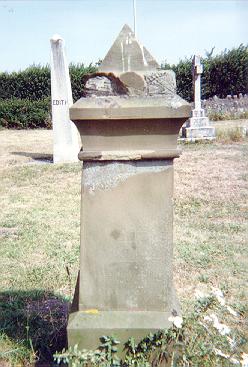 .. . .
.. . .

When I realized that Wennington, Essex, is on the eastern edge of greater London, I rode out to the churchyard there to take a look at Henry Perigal's monument. I had imagined that Wennington would be a sleepy old tree-shaded village with a lot of character. But in July, 1999, there was not much of a village, old or new, near the church, and not much shade either. I had pictured Perigal's monument as being out of granite and at least seven feet tall. But it was maybe half that high, not of granite, and it showed the effects of a hundred years in the weather and an indifferent repair.
 .. . .
.. . .

For a photograph of the church (St. Mary and St. Peter), see Wennington Village Church.
Hopefully the monument still stands, declaring in its inscription on the east front (above left):SACRED
TO THE MEMORY OF
HENRY PERIGAL
( CYCLOPS )
F.R.A.S. F.R.M.S. M.R.I.
40 YEARS TREASR OF R MET S &C
BORN 1ST APRIL 1801.
DIED 6TH JUNE 1898.
CREMATED AT WOKING
HIS ASHES LIE BENEATH
DESCENDED FROM A HUGUENOT FAMILY
WHO ESCAPED FROM FRANCE TO ENGLAND
AFTER THE REVOCATION OF THE
EDICT OF NANTES IN 1688.
On the upper plinth, the inscription continues:A LEARNED AND INGENIOUS GEOMETRICIAN
HE INVESTIGATED AND ILLUSTRATED
THE LAWS OF
COMPOUND CIRCULAR MOTION.
Now lost from the lower plinth, except for the last three letters of the first line, is:GREATLY BELOVED AND HIGHLY ESTEEMED
BY A LARGE CIRCLE OF RELATIVES AND FRIENDS.
"WHEN I CONSIDER THY HEAVENS THE WORK OF
THY FINGERS, THE MOON AND THE STARS WHICH THOU
HAST ORDAINED, WHAT IS MAN THAT THOU ART
MINDFUL OF HIM?" . . . PS. VIII., 3. 4.
On the south front, in very fine lines that do not show up at all in the above right image, is Perigal's 5-piece dissection of squares that illustrates the Pythagorean theorem. (The features are just barely discernible with a magnifying glass in my original photograph.) The illustration has a right triangle sitting on its hypotenuse, with each of the three squares sitting on a corresponding side. The top vertex of the triangle is labeled "C", the bottom left "A" and the bottom right "B". The smallest square (the largest dark smudge in my photo) is on the upper left of the diagram, labeled with an "H". The middle square is on the upper right, is divided into the four pieces, which are labeled by "P", "R", "G" and "L". The largest square is below the triangle and is divided into five pieces, with the pieces having the same labels in the corresponding pieces above. Strangely, the two pieces labeled with "G" have dark smudges on them. Below the illustration is the inscription:AB2 = AC2 + CB2
Discovered by H. P.
1830.
The inscriptions are verified using the pamphlet by F. Perigal that appears in my book's bibliography.
In the summer of 2001, Bill Casselman, who was planning a bicycle trip in Europe, asked me for directions on how to get to Perigal's monument. Using my directions, Bill found the monument, took better pictures than I had, and wrote a nifty article for the online math magazine +plus. Entitled `On the dissecting table', the article appears in issue 16: September 2001.
Copyright 1999-2003, Greg N. Frederickson.
Permission is granted to any purchaser of
Dissections: Plane & Fancy
to print out a copy
of this page for his or her own personal use.
Last updated July 9, 2003.